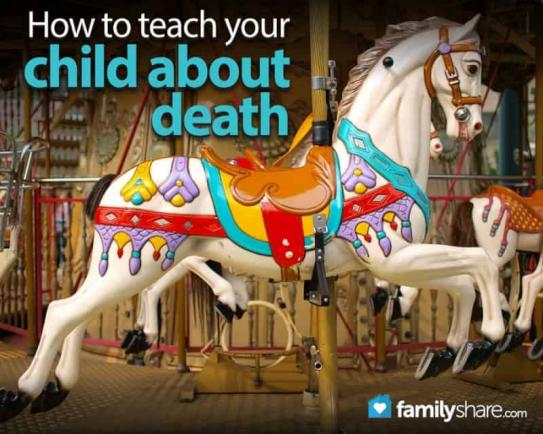
The words of a childhood song taught me that life is like taking a turn on a carousel, each person entering and disembarking at a different time, each having had a unique experience. I believe death is like getting off a ride, a natural part of the cycle of life. But explaining this to my children has been a challenging, tender, even enlightening experience. Here are five tips to guide you through how to help a child understand death and dying.
Take the opportunity to teach
. The death of someone in a child's sphere of influence can be an opportunity to teach about love, religious beliefs, compassion and living life to the fullest, to name a few. While you may not have all the answers a child is seeking, you can teach what you know in clear terms and openly admit your ignorance on what you don't know.
When my 3-year-old went to the hospital to visit his grandmother for the last time, she was full of tubes and surrounded by medical equipment that was frightening to him. Since it was Halloween time, he was dressed in costume. I explained that just like he was still himself under the costume, his grandmother looked different on the outside but was the same on the inside. I then told him that even after she was gone, he could carry her with him on the inside. Take time to teach in ways children can understand and appreciate.
Allow for grieving
. Children need to know that grieving is a natural and accepted part of loss. Preparing a child for the feelings of sadness, loneliness, fear, anger and longing that will come will help familiarize and normalize the process. Grief is a process. There is no set timetable. Allow your child time and space to sit with his feelings. Additionally, let your child see you grieve. Like everything else in parenting, modeling the grieving process is the key.
Create a healthy channel for feelings
. When a child is mourning the loss of a loved one she will experience a whole gamut of feelings. She will need constructive and healing avenues for these emotions. Encourage her to write, draw, dance, and especially talk out her feelings. If she isn't getting it out, she's taking it in. Children and adults who hide their feelings can develop various negative social, emotional and physical side effects. Grief counseling or therapy sessions may be good options for the child who tends to bury or act out negatively on her emotions.
Honor memories
. "Good night, sleep tight; to wake up bright in the morning light; to do what's right with all your might. I love you."� Christine tucks her children to bed with this rhyme every night and tells them she learned it from their grandmother. Having lost her own mother when she was a teenager, Christine feels it is important to "find reminders that bring positive memories and experiences and share them with others."� While her children never met their grandmother, they sing "Happy Birthday"� each year on the day she was born, talk about holiday traditions she established and enjoy keepsakes she possessed. Incorporating stories and remembrances into everyday life can keep a loved one close and communicates to children that their loved one is gone but not forgotten.
Console, comfort and cuddle
. Children who are acquainted with death will need extra nurturing and care. In the midst of grief following a death, it may be tempting for children to push others away and isolate themselves. This is the time when they need comfort and consolation more than ever. Give them plenty of positive attention and remember the power of touch. Seeking to soothe another can be healing for both parties and is a good outlet for pain. Tread softly, speak gently, embrace affectionately.
When a carousel ride stops, so does the music. Keep the music alive in your child's life by helping them understand that death is a part of the ride. Teach, grieve, feel, honor memories and comfort a child faced with the death of someone special. Be open to all that a child can teach you in the process.

